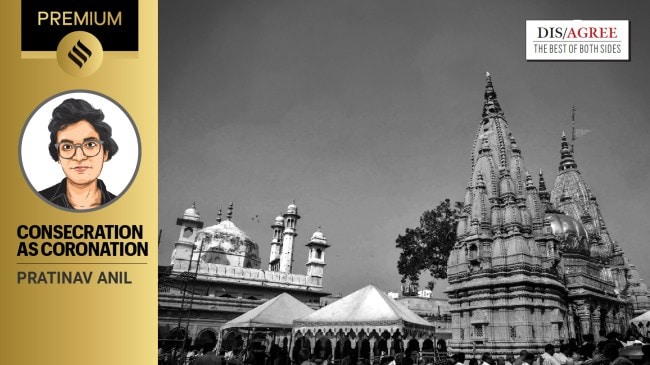Opinion Best of Both Sides | Pratinav Anil writes: A mosque in India vs a temple in Pakistan
What their contrasting fates tell us about India's journey from democracy to theocracy
 Varanasi: The Gyanvapi Mosque complex as seen from the Kashi Vishwanath Temple after the district court granted the family of a priest the right to worship Hindu deities in the Gyanvapi mosque cellar, in Varanasi, Wednesday, Jan. 31, 2024. (PTI Photo)
Varanasi: The Gyanvapi Mosque complex as seen from the Kashi Vishwanath Temple after the district court granted the family of a priest the right to worship Hindu deities in the Gyanvapi mosque cellar, in Varanasi, Wednesday, Jan. 31, 2024. (PTI Photo) Is it apposite to begin an article on the new India in Pakistan? Strolling in Lahore recently, a friend and I stumbled upon the Bansi Dhar Temple in the walled city, tucked away behind an intriguing jharokha with Hindu motifs. The story goes that in the retaliatory desecrations of Hindu temples in Pakistan following the flattening of the Babri Masjid in 1992, mighty force was brought to bear on its robust façade. To no avail. Derelict, the temple nonetheless remains standing. The Islamic state is still work in progress.
But so, too, is the Hindu state. For decades, we have prided ourselves on not being a “Hindu Pakistan”. Yet, the claim has always rested on rather flimsy foundations. Right from Independence, theocratic temptation has proven impossible to resist. Researches into Nehru’s India have thrown up a grim catalogue of contemporary parallels: Riots in which the victims are disproportionately Muslim; ministers and chief ministers condoning violence against minorities even as their boss swears by secularism and diversity; the dispossession and deportation of Muslims in the northeast; Muslim underrepresentation in Parliament and public life.
Yet, the contrasting fates of the Bansi Dhar Temple and Babri Masjid tell us that, at this juncture, we may be winning the theocratic Olympics. As it is, “Indian secularism” was always too special to be encumbered by such mundanities as the separation of church and state. Ambedkar’s Constitution favoured religious personal law and frowned upon cow slaughter. Hours before the stroke of
midnight on August 15, 1947, Nehru presided over priestly celebrations, all holy water and vermilion. Following in our founding fathers’ footsteps, Modi, too, believes religion is too important to be left to the clerics.
Since Independence, Ayodhya has been a microcosm of our republic. Here we have a window into the world of actually existing Indian secularism — and it is a world away from the orotund oratory of our rulers. Here it emerges all too clearly that the groundwork for Hindu India was laid by the Congress. It was in 1949 that an idol of Ram serendipitously “appeared” in the Babri Masjid, leading to riots and army intervention. Heeding extreme Hindu sentiment, the Congress decided to leave the idol untouched, even as the mosque was placed under lock and key.
Fast-forward 36 years and you have Vir Bahadur Singh, Congress chief minister of UP, opening the locks under VHP pressure. Riots rocked north India, and Muslims staged their biggest protest since Independence. Determined not to let the Hindu nationalists steal a march on him, Rajiv Gandhi endorsed the VHP’s ceremonial consecration of bricks to build a temple in 1989. A few days later, he launched his election campaign a stone’s throw from the Babri Masjid, promising Ram Rajya.
By 1990, Ayodhya had acquired a renewed urgency for the BJP. Mandir became a stick to beat Mandal, the unity of Hindus pitched against the Muslim minority in a cynical deflection from the divisions within Hinduism. Upper-caste student immolations protesting the quota for backward castes all too graphically illustrated those intercaste divisions, and therefore the challenge for the BJP. Accordingly, like a Ram redivivus, L K Advani commenced on his rath yatra.
As Mandir began to trump Mandal, two backward-caste chief ministers, Mulayam Singh Yadav and Lalu Prasad, threw a spanner in the works. Advani was arrested in Bihar. High drama ensued in Delhi, and the BJP pulled out of the V P Singh government. A year later, on the strength of a macabre campaign featuring bones and ashes of Ayodhya’s “martyrs” — allegedly killed by the police — Lucknow fell to the BJP’s Kalyan Singh. Meanwhile, in Delhi, the Congress returned to power. The stage, then, was set for a grand contest that in the event never transpired, once again highlighting the ideological convergence between the Congress and BJP. The difference between the two is often only a question of degree rather than of kind. This, incidentally, also explains the ubiquity of defection between the two major parties.
So it was that Narasimha Rao fiddled while Hindu nationalists razed the mosque. The Congress’ neutrality had backfired. Mandal was buried by Mandir on the streets of Mumbai. Cashing in on the riots there and elsewhere in 1993, the BJP rode to power three years later. Since then, secular pretences have been dropped.
For decades now, Indian liberals have banged on about the genius of “Indian secularism”: Not the separation of church and state but rather ‘equidistance’ — indeed, equal admiration of both major faiths. The effects of placing religion — inevitably, the majority’s religion — on a pedestal are now plain to see. The pink sandstone temple comes with a price tag of Rs 18,000 crore. The mosque being built for Muslims, by contrast, is a rather diminutive affair.
For liberals today, all that is left is the cold comfort of black comedy. A third victory for Modi is now a foregone conclusion. In the run-up to the election in April, much will be made of the simple elision of Ram’s consecration and Modi’s coronation. Here, then, is the making of not so much the world’s largest democracy as the world’s largest theocracy.
The writer is a historian at the University of Oxford and author of Another India






